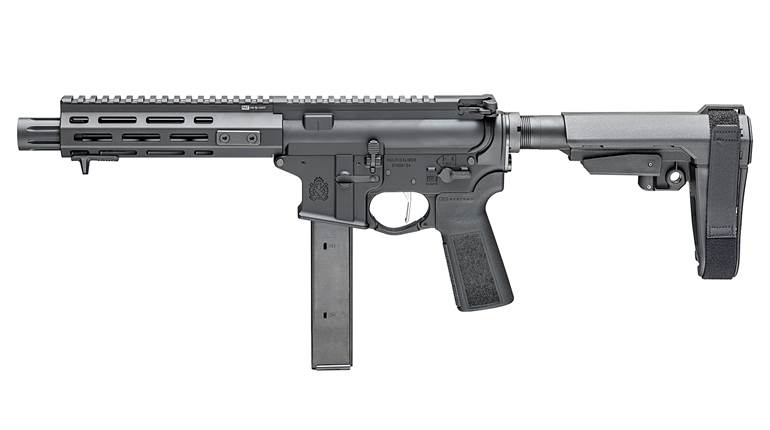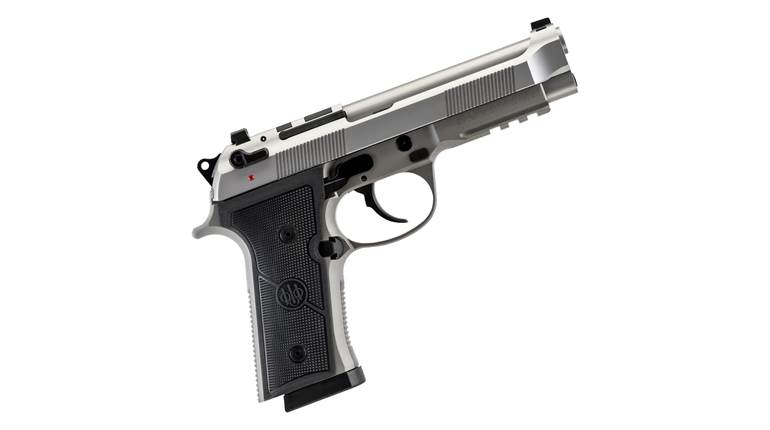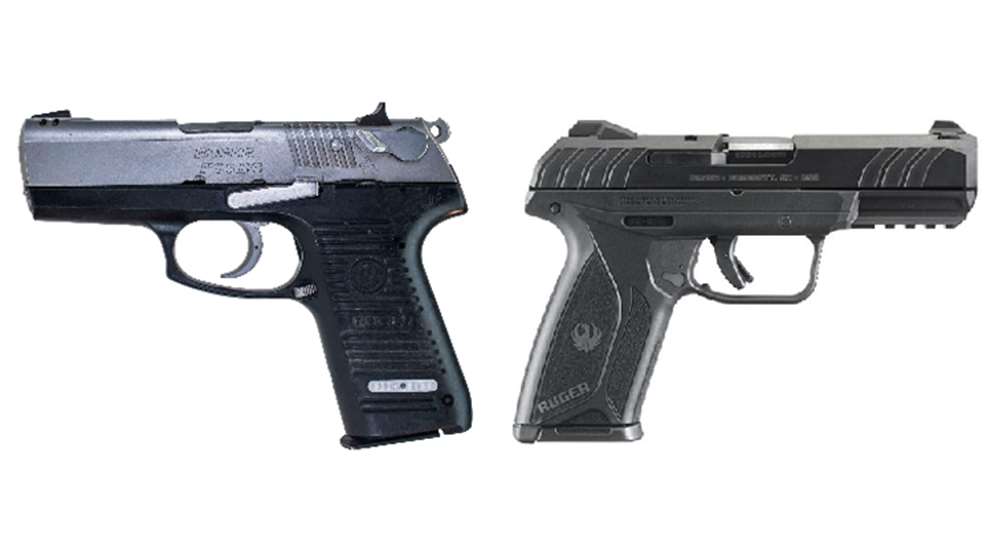
The year 1998 was filled with memorable (if not all positive) events. The XVIII Winter Olympics were held in Nagano, Japan. Home computing enthusiasts were busily Hotmailing each other at blistering 56k dial-up modem speeds, and President Bill Clinton was dancing the verbal two-step regarding the word "is."
At that time, my wife and I were both working our way through school in a small college town. Times were tight, so much so that during those years we experienced the unforgettable Semester-O'-Ramen, a long winter stretch in which no less than one meal a day (sometimes more) consisted of a single package of what we now call “our favorite food substitute.” But, by 1998 I had squirreled away enough cash in my meager shooting budget to purchase a less expensive handgun.
I found it at a small sporting goods store off of Main Street. It was a brand new Ruger P95 pistol chambered in 9 mm. This model's full designation is KP95DC, with the K indicating a stainless steel slide and DC standing for “Decocker Only.” Introduced to the market in 1996, the P95 series was the first pistol model Ruger offered with a high-strength, fiberglass-reinforced polyurethane frame (based on Dow Chemical's Isoplast polymer). The clerk explained that a polymer frame cost less to produce than the aluminum frame of the P89 and reduced the gun's weight by a few ounces. Although the suggested retail for that P95 in the 1998 Ruger catalog (yes, it was printed on paper and mailed out to folks through the U.S. Postal Service in those days) was listed as $389, I could buy it on sale for just $318, or go with a blued slide model for only $299.
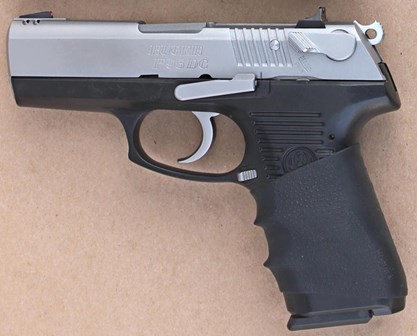
I went home, counted my money, hunted for loose change under the couch cushions and gently cajoled my wife into spending the extra $19 to invest in the stainless slide since it would withstand wear and tear better than the blued one. Not long after purchasing the P95, I picked up a Hunter 2800-2 leather belt holster at the same sporting goods store and “converted” an old but functional button-flap belt pouch into a magazine carrier to form a carry rig for what turned out to be an utterly reliable 9 mm pistol.
Over the years, the P95 has served as a concealed-carry gun, a trunk gun, a plinker at the range and as a home-defense pistol tucked into a quick-access strong box. While other guns have come and gone, I have yet to find a good reason to part with this one. This pistol's value as an on-hand asset has remained greater than the amount of cash it would bring as a trade-in for a newer model. The P95 was phased out of production in October 2013.
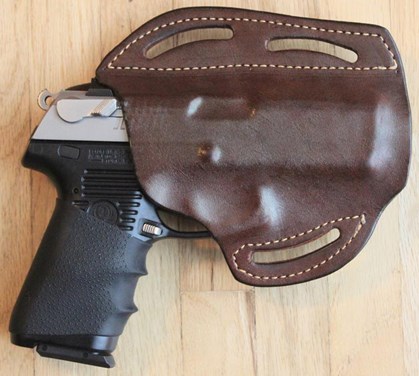
In the years since the P95 faded out of Ruger's catalog, we've seen several models introduced among the other polymer-framed semi-automatics the company offers. The SR line has grown to include .45 ACP models. The sub-compact LC9 single-stack 9 mm series introduced in 2011 has taken firm foot hold in the civilian concealed-carry market and continues to grow with the addition of the new budget priced EC9s model. And more recently, the American duty-grade pistol line was introduced in 2015.
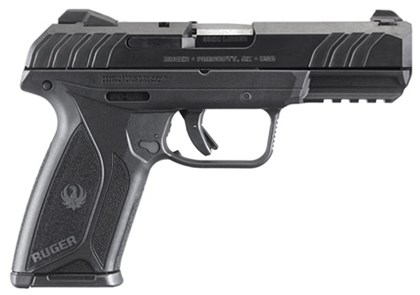
For 2018, Ruger opted to tackle two of the company's catalog gaps with the new Security-9 pistol.
First, a just-right size compact 9 mm model that splits the difference between the duty-sized American and the sub-compact LC9s was needed (like the G19 in the Glock line-up). The other goal was to introduce an easy-to-carry double-stack pistol for shooting enthusiasts on a budget. With a suggested retail price of $379, the Security-9 is likely to sell for prices closer to $300.
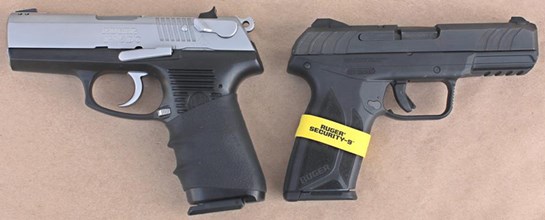
While working with the Security-9, the realization struck me that I had a unique opportunity to examine Ruger's first budget-friendly polymer-framed pistol, the P95, side-by-side with the company's latest offering in the same category and see for myself what's changed and what has remained the same over the course of 20 years of semi-automatic evolution.
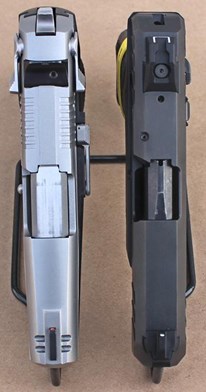
The P95's P-Series heritage is clearly present in the rounded contours of the slide, the exposed hammer and the shape of the frame. Indications of the investment casting processes used to form the metallic components can be seen throughout the pistol, but they are most evident in the slide. The Security-9 is, for all intents and purposes, an enlarged version of the LCP II .380 ACP pistol.
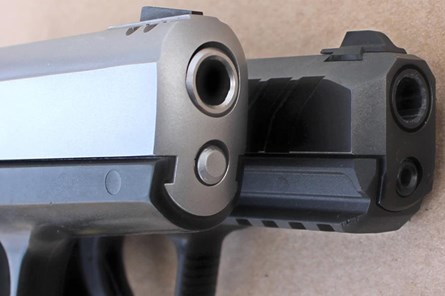
As a result, the features of the slide and frame have a distinctive angular appearance. The slide exhibits a good deal more CNC machining than that of the P95. While both pistols have comparable slide and barrel length, the Security-9 is 6.25 oz. lighter with a 0.7" shorter grip frame.
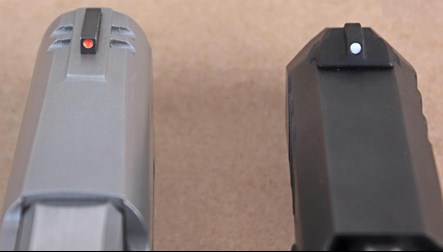
The P95's white-dot front sight is metallic and secured to the slide by two pins. I used an old-school high visibility front sight technique known as Testor's 1173TT, which is to say, a dollop of florescent orange enamel paint to brighten it up a bit. The Security-9 is fitted with a dovetailed polymer front sight with a white-dot insert.
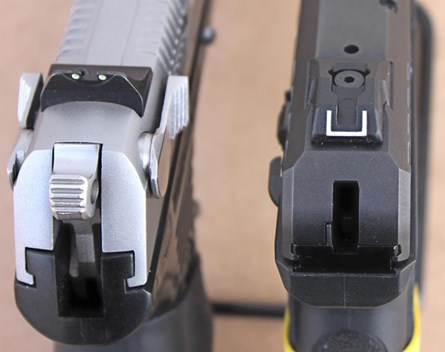
Both pistols have dovetailed rear sights secured by screws that allow for drift adjustment to correct for windage. The P95's blued steel sight has a square notch and white dots while the Security-9's is made of polymer with a Glock-style white “U” outline.
You may have noticed, when looking at the photo of the rear sights, how much thicker the rails of the P95 are (0.23") when compared to the Security-9 (0.10"). This is because the designers at Ruger made a gutsy move with the P95 by having the slide ride directly on a set of six polymer rails that were integral to the frame: a pair of 1.3" long rails by the hammer, a 1.10" and a 0.85" rail above the trigger guard and a matched pair of 2.45" rails along the interior of the dust cover to support an ax-blade shaped slide extension located at the muzzle.
Plenty of folks were dubious about how well the polymer rails would hold up. However, the P95 remained in production for 17 years and my 20-year-old example is still running right along without a hitch. The Security-9 employs a milled aluminum chassis inserted into the polymer frame to support the trigger assembly and provide a single pair of 4.15" long slide rails. The use of a chassis allows for a thinner, lighter polymer frame.
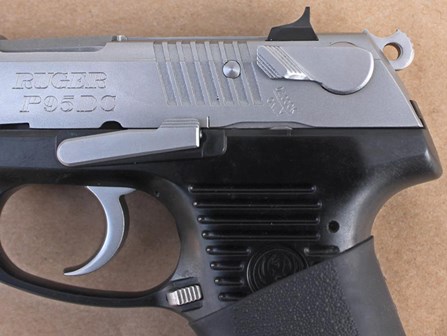
This version of the P95 has an ambidextrous decocker lever that can be used to safely drop the hammer when cocked. While this decocker has a wedge shaped extension to make it easier to operate, it tends to dig into the hip when carried. In later models, the decocker has a flat profile. The slide stop also serves as the takedown pin, much like those found on 1911-type pistols. The ambidextrous magazine release lever is unusual in that it must be pressed forward of the grip (instead of inward like a button) to release the magazine. It's convenient to operate but easier to unintentionally bump release than some designs. Later models were fitted with lower profile releases.
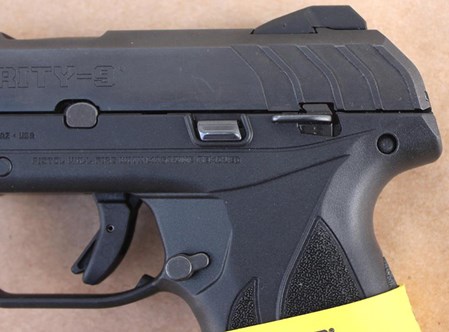
Although the Security-9 uses a hammer instead of a striker, there are no hammer controls on the slide. The pre-cocked, double-action hammer has been internalized and is visible through a slot in the slide. A diminutive thumb safety is located on the left side of the frame. The takedown pin and slide stop have been separated with the slide stop being much smaller than that found on the P95. The magazine release is a familiar, round profile push button located on the left side of the frame.
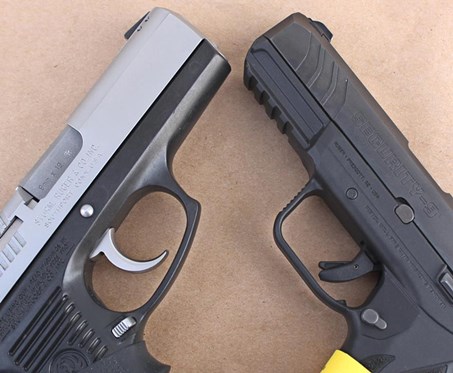
P95 frames were produced without an accessory rail or molded in non-slip grip texturing until 2005 when the P95PR was introduced. The Security-9 ships with a 1.5" long four-slot accessory rail, compatible with popular Glock and Picatinny rail-mounted accessories, molded into the dust cover. Both pistols have finger rests along the front of the trigger guard but the Security-9's is more distinctive.
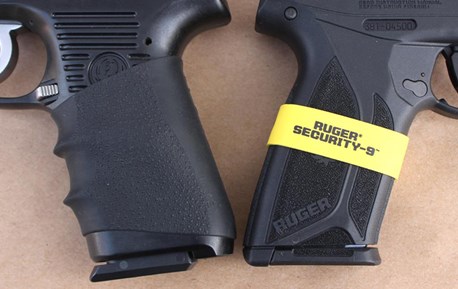
One of the P95's greatest strengths is its smooth and relatively light trigger pull. The steel bow trigger assembly is mounted directly into the polymer frame resulting in a zero-grittiness liquid feel. Double-action trigger pull is as high as 12 lbs. to 15 lbs. in some models, but this gun's trigger is only 9 lbs. 6 oz. in double-action mode. When the pistol is fired in single-action mode (hammer cocked) the trigger pull drops to 4 lbs. even. The Security-9's polymer trigger with its integrated safety lever exhibited a consistent 5-lbs. 5-oz. trigger pull for every shot fired. The trigger reset is short with an audible and tangible click.
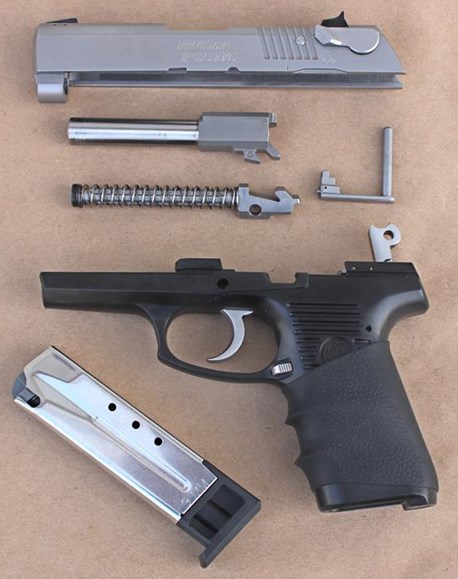
If I had to pick the P95's greatest weakness it would be the styling of the grip frame. The frontstraps and backstraps are perfectly smooth, resulting in a slick, greasy feel when hands are sweaty. The grooves molded into the sides of the grip don't improve the purchase much. The P95's handling improved significantly with the installation of a Hogue HandAll grip sleeve that the pistol wears to this day.
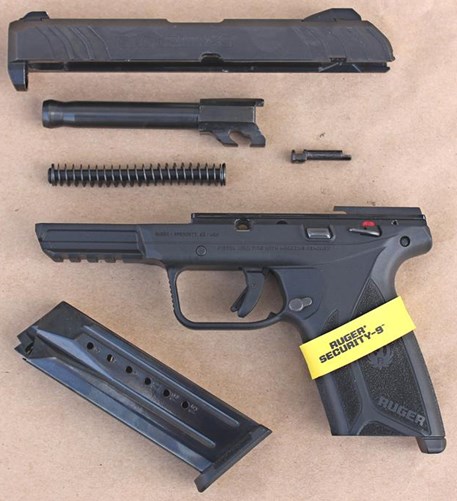
The Security-9 grip shows a significant leap forward in ergonomic grip design. All four sides of this thin profile grip are treated with a molded in non-slip texturing reminiscent of skate board tape but without the abrasiveness. Indentations, located behind the trigger housing, make it much easier to reach the trigger and magazine release. This pistol comfortably fits a much broader range of hand sizes. Both pistols have grip extensions that prevent the magazine base plate from pinching the shooting hand.
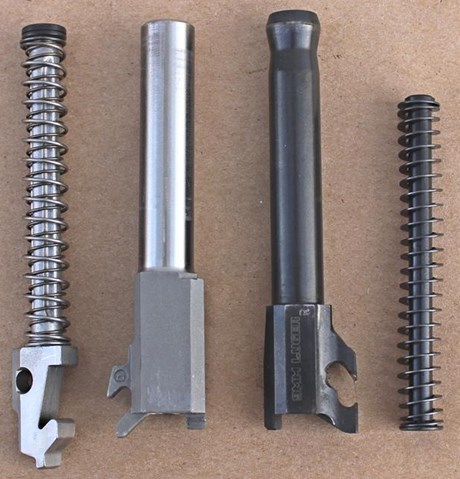
The stainless steel barrel of the P95 is supported by a caste, fluted stainless steel guide rod supporting two captured and overlapping round wire recoil springs. The Security-9 sports a Glock-like polymer recoil rod with a single flat wire spring that supports a blued steel barrel with a witness hole located at the top of the chamber.
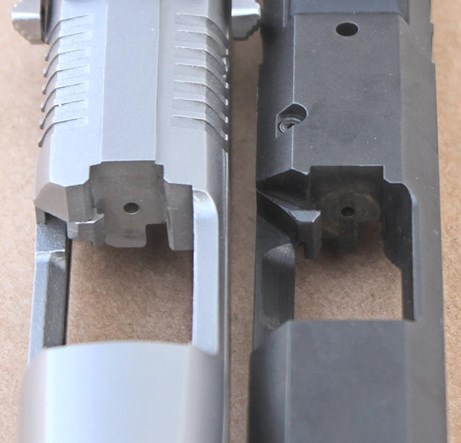
One thing that hasn't changed over the years is Ruger's use of oversized extractor claws, which lend to reliable operation.
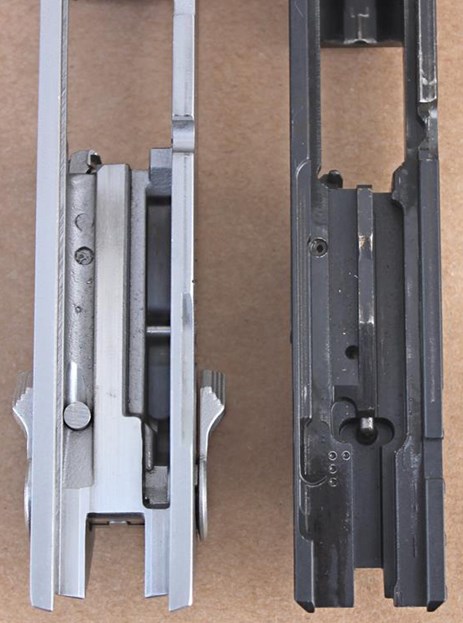
Looking at the interior of the taller, heavier P95 slide reveals more casting marks that were not buffed out since they did not affect the reliability of the pistol. The Security-9 slide is a shorter, leaner affair that has undergone more extensive machining and refinement (which is difficult to appreciate in the photo because of the slide's dark coloration and fresh layer of lubricant).
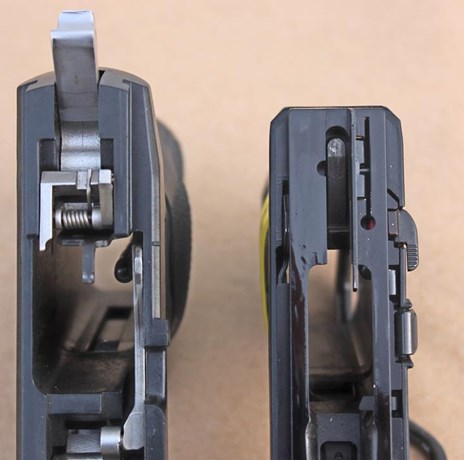
The P95's DA/SA hammer, which is mounted directly into the frame like the trigger, looks positively bulky next to the internal double-action only hammer of the Security-9.
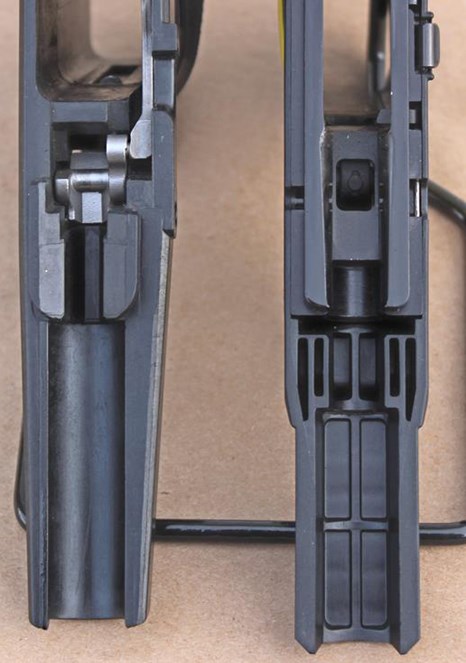
A peek inside these pistol's dust covers shows how much the polymer molding process has changed. The P95's frame is a clever but simple, slab-like design. The Security-9's more sophisticated use of chambers, ridges and supports provide the rigidity needed at a lower weight.
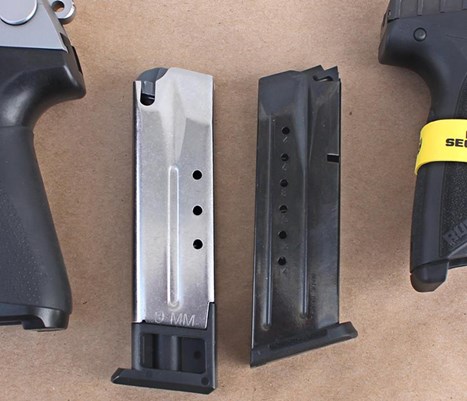
When I purchased the P95, the country was four years into the Clinton Era Federal Assault Weapons Ban (AWB), which would eventually expire on Sept. 13, 2004. As a result, the P95 was sold with two politically correct 10-round P-Series magazines instead of the original 15-round models (which Ruger started shipping again in 2005). Despite being over half an inch shorter than the P-Series magazines, the blued steel Security-9 magazines hold a total of 15 rounds for those customers who live in states that allow them.
I'm happy to report that in its 20 years of service to my family, the P95 has only ever been called upon to knock down steel plates, punch holes in paper targets and blow up suspicious looking dirt clods lurking around the berms at the shooting range. That's the great thing about well-made budget guns, they'll provide decades of service when properly cared for and there's rarely a good reason to sell them. I imagine that someday my future grandkids will look this gun over and ask me where I put the stone ax that came with it.
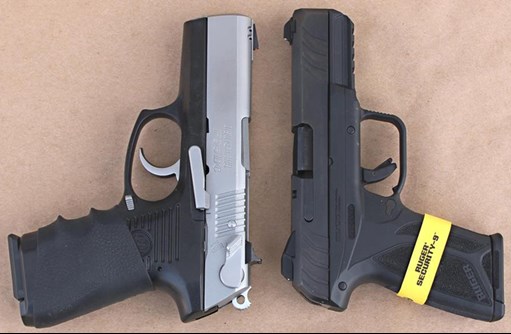
That being said, don't think that a bit of sentimentality for a particular pistol makes me a Luddite. The new Security-9 (the range test is available here) is a lighter, more compact pistol loaded with features today's concealed-carry and home-defense practitioners are looking for. If the P95 were in production today, and the price was adjusted for inflation, it would have a suggested retail of nearly $600. The fact that the Security-9 will be selling for around 300 of today's dollars is clear evidence that the company is still working to keep their commitment to provide the average person access to quality firearms.
Specifications:
Manufacturer: Sturm, Ruger & Co.
Model: KP95DC
Action: Double Action/Single Action Semi-Automatic
Caliber: 9 mm
Slide: Stainless Steel
Slide Serrations: Back Only
Frame: Long-Glass Fiber Reinforced Polyurethane
Front Sight: Pinned Metallic White Dot
Rear Sight: Dovetailed Metallic White Dot
Barrel Length: 3.9″
Overall Length: 7.2″
Height: 5.7″
Slide Width: 1.07"
Grip Width: 1.16"
Double-Action Trigger Pull: 9 lbs. 6 oz. (As Tested)
Single-Action Trigger Pull: 4 lbs. (As Tested)
Weight: 30 oz. with Empty Magazine
Capacity: 10+1 Rounds
Twist: 1:10” RH
Rifle Grooves: 6
Accessories: Two 10-Round Magazines Lockable Hard Case, Lock,
MSRP (1998): $389
Model: Security-9 (#3810)
Action: Pre-cocked Double Action Semi-Automatic
Caliber: 9 mm
Slide: Blued Through-Hardened Chrome-Moly Steel
Slide Serrations: Front and Back
Chassis: Milled Aluminum, Hard-Coat Anodized
Frame: Textured Long-Glass Fiber Reinforced Nylon
Front Sight: Dovetailed Polymer White Dot
Rear Sight: Dovetailed Polymer White Outline
Barrel Length: 4"
Overall Length: 7.24"
Height: 5"
Slide Width: 1.03"
Grip Width: 1.17"
Trigger Pull: 5 lbs. 5 oz. (As Tested)
Weight: 23.75 oz. with Empty Magazine
Capacity: 15+1 Rounds
Twist: 1:10” RH
Rifle Grooves: 6
Accessories: Two Magazines, Cable Lock, Owner's Manual
MSRP (2018): $379












